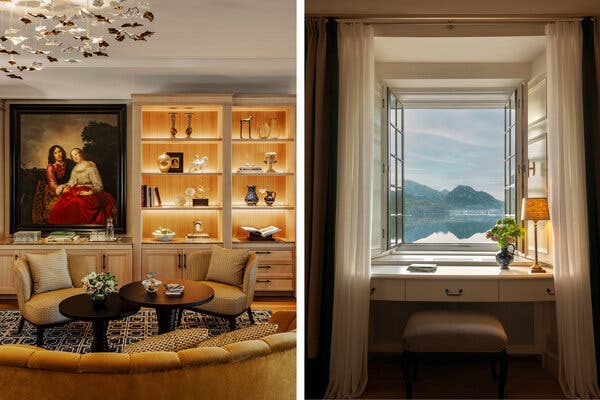Contents
The T List
Plus: art about office life, colorful rope rugs — and more.
Stay Here
Rosewood Restores Schloss Fuschl
The castles of the German and Austrian Alps are known for their fairy-tale quality. The iconic turreted silhouette in the background of the Disney logo was, in fact, modeled after Neuschwanstein, King Ludwig II’s Bavarian palace near the border of the two countries. Schloss Fuschl, located on an evergreen-ringed, emerald-hued glacial lake 20 minutes outside of Salzburg, is no exception. Constructed in 1461, the sprawling stone manse served for four centuries as a luxurious hunting lodge for the Prince-Archbishops of Salzburg, who ruled the area under the Holy Roman Empire, as well as their royal guests. After World War II, the schloss (“castle” in German) was converted into a hotel that operated mostly seasonally, from April through October, until 2022, when Rosewood Hotels & Resorts bought the property and embarked on a restoration. On July 1, Schloss Fuschl will reopen with 98 guest rooms including six stand-alone chalets. There are six restaurants and bars on-site; indoor and outdoor infinity pools; a spa with three saunas and eight treatment rooms; and access to Lake Fuschl: Fishing expeditions, boat trips and herbalist-led nature walks can be arranged. While the schloss was never home to the likes of Cinderella or Rapunzel, it did host a movie princess: Fans of midcentury cinema might recognize the place from the German-French actress Romy Schneider’s “Sisi” films — a historical trilogy about the young Elisabeth of Austria — which were shot there in the 1950s. Today, the Sisi Teesalon bears the character’s name and will offer afternoon tea service with a wide range of homemade pastries including the Schloss Fuschl Torte, a chocolate-hazelnut truffle cake first created in the house kitchen more than 30 years ago. Rates from about $695 per night, rosewoodhotels.com.
See THis
At the New Michael Werner Gallery in Beverly Hills, Two Painters in Conversation Across Time
When it opens in Beverly Hills on June 22, Michael Werner Gallery’s Los Angeles outpost will feature works by the 19th-century French artist Pierre Puvis de Chavannes and the German postwar painter Markus Lüpertz. The gallery’s co-owner Gordon VeneKlasen chose these artists in part to surprise viewers: “Nobody expects to see those two artists in a show in L.A.,” he says. The show reveals Lüpertz’s longtime admiration of his predecessor: The works on view, dating from 2013 to a decade later, incorporate and recontextualize images from Puvis’s work, such as “Étude pour Le Pauvre Pêcheur” (“Study for The Poor Fisherman”) an 1881 charcoal sketch of a fisherman and two figures, which in Lüpertz’s painting “Besuch von Pierre” (“Visit From Pierre”) (2018) becomes a vista devoid of people. VeneKlasen wants this interplay between two eras to characterize the gallery’s future exhibits. “I really wanted to establish that we’re attached to history and attached to the modern and the contemporary at the same time,” he says. Other exhibitions planned in the minimalist space, which wraps around a courtyard, include those featuring work by the 20th-century American conceptual artist James Lee Byars, the British painter and musician Issy Wood and the German artist Florian Krewer. The gallery will also host a series of events, beginning with a Sept. 7 spoken-word performance featuring California poets. “Markus Lüpertz, Pierre Puvis de Chavannes” will be on view at Michael Werner Gallery, Beverly Hills, from June 22 to Sept. 7, michaelwerner.com.
Covet This
Colorful Rugs Inspired by Sailing Rope
For the Rotterdam-based designer Bertjan Pot, the most satisfying experiments often spring from unexpected odds and ends. Wire strainers, plastic jugs and golf balls turn up in an ongoing series of lamps called Crafty Lights, while a suite of high-backed sofas created for the TextielMuseum in the nearby city of Tilburg features bright polypropylene string crisscrossed around a spare metal frame. “I don’t even keep a sketchbook,” Pot says, reflecting on his improvisational approach to design. “Most of it is just done hands-on by playing around with materials.” His latest collaboration with the New York-based textile house Maharam nods to a longtime fascination with marine line (high-performance sailing rope), which Pot is known to fashion into whimsical masks. Two new rugs — Pop, coiled in an oval or circle, and Groove, a riff on the checkerboard — are made of multicolor rope that lends a mesmerizing, dimensional effect. Suitable for both indoor and outdoor use, the rugs have a stylistic kinship with Americana. “What I like about folk art, and maybe tramp art and outsider art, is that there’s always a clear link to the hands that’ve made it,” the designer says — a quality also found in Groove’s macramé knot. (Weavers in India learned the technique by studying one of Pot’s handmade samples.) Objects encoded with human touch are the ones “you put on a pedestal,” Pot says. “Or it might not even be a pedestal. Maybe just a nice place: That could be the floor.” From $258, maraham.com.
Thank you for your patience while we verify access.
